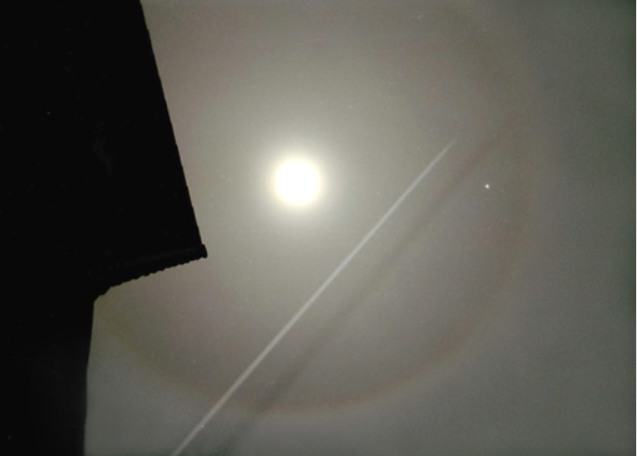Contrail Shadows
Contrail Shadows: A Fascinating Optical Phenomenon
Contrail shadows are a captivating atmospheric optics phenomenon that sometimes appears counter-intuitive. These shadows are created when the moon or the sun casts a shadow of an aircraft contrail onto a lower layer of clouds or haze. The interplay of light, clouds, and ice crystals gives rise to a mesmerizing display in the sky.
Contrails, short for "condensation trails," are formed when the hot engine exhaust of an aircraft mixes with the cold air in the upper atmosphere. This causes the water vapor present in the exhaust to condense into tiny water droplets and ice crystals. These suspended particles create a visible cloud-like trail behind the aircraft.
Like other clouds, contrails cast shadows. However, what makes contrail shadows particularly intriguing is their appearance on a lower level thin layer of cirrus haze. It may seem as though the shadow is cast by a bright light shining upwards from a lower altitude, but the reality is quite different. The aircraft and its contrail are actually high up in the sky, while the shadow is cast downwards onto the haze layer by the moon or the sun.
The phenomenon of contrail shadows can be observed when an aircraft passes through a thin layer of cirrus haze. This thin layer acts as a canvas upon which the shadow is projected. Additionally, ice crystals present in the haze layer can further enhance the visual spectacle by creating a 22º halo around the shadow.
To understand the appearance of contrail shadows, it is helpful to visualize the line of sight between the observer's eye and the aircraft contrail. The shadow appears to the right of this line of sight when viewed from the other side of the cirrus cloud layer, giving it a distinct and intriguing placement in the sky.
Contrail shadows serve as a reminder of the complex interplay between light, clouds, and atmospheric conditions. They showcase how seemingly simple phenomena can result in visually stunning displays. The ethereal beauty of these shadows adds an extra layer of fascination to the already captivating world of atmospheric optics.
In conclusion, contrail shadows are a captivating optical phenomenon that occurs when the moon or the sun casts a shadow of an aircraft contrail onto a lower layer of clouds or haze. The interplay of light, clouds, and ice crystals creates a visually stunning display in the sky. Understanding the science behind contrail shadows allows us to appreciate the intricate beauty of the natural world and the wonders it holds.

The Moon, Jupiter, an aircraft contrail, its shadow cast by the moon and a 22º ice halo.
Imaged by Jean-Marie Maillard (site) of Belgium in October 2000.
Contrail shadows sometimes appear counter-intuitive. This one seems cast by a low altitude bright light shining upwards and casting the contrail shadow on a higher cloud.
The reverse is the case. The aircraft and its trail are high up and seen through a lower level thin layer of cirrus haze. The Moon has cast a shadow of the contrail downwards onto the haze layer. And quite independently of aircraft and shadows, ice crystals in the haze layer have created the 22º halo.
Image ©J-M Maillard, shown with permission

Contrails are clouds of small water droplets and ice crystals condensed from the engine exhaust and from waper vapour already in the air cooled by rarefaction over the wings and fuselage.
Like other clouds they cast shadows. In the photograph the shadow falls on a thin tower layer of cirrus cloud. We see the shadow from the other side of the layer, like looking through the back of a screen.
The shadow appears to the right of the line of sight between the contrast itself and the eye.
Note: this article has been automatically converted from the old site and may not appear as intended. You can find the original article here.
Reference Atmospheric Optics
If you use any of the definitions, information, or data presented on Atmospheric Optics, please copy the link or reference below to properly credit us as the reference source. Thank you!
-
<a href="https://atoptics.co.uk/blog/contrail-shadows/">Contrail Shadows</a>
-
"Contrail Shadows". Atmospheric Optics. Accessed on December 21, 2024. https://atoptics.co.uk/blog/contrail-shadows/.
-
"Contrail Shadows". Atmospheric Optics, https://atoptics.co.uk/blog/contrail-shadows/. Accessed 21 December, 2024
-
Contrail Shadows. Atmospheric Optics. Retrieved from https://atoptics.co.uk/blog/contrail-shadows/.